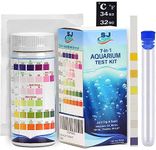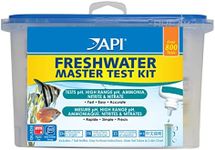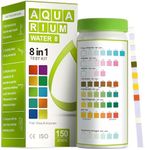Buying Guide for the Best Aquarium Test Kits
Choosing the right aquarium test kit is crucial for maintaining a healthy environment for your aquatic pets. A good test kit helps you monitor the water quality, ensuring that the conditions are optimal for the fish and other inhabitants. When selecting an aquarium test kit, it's important to consider several key specifications to ensure you get the best fit for your needs. Here are the key specs to look out for and how to navigate them.Parameters TestedThis spec refers to the different water quality parameters that the test kit can measure, such as pH, ammonia, nitrite, nitrate, and others. These parameters are important because they indicate the health of the water and, consequently, the well-being of your aquatic life. Basic kits usually test for pH, ammonia, nitrite, and nitrate, which are essential for most freshwater tanks. More advanced kits may include tests for additional parameters like phosphate, calcium, and magnesium, which are important for saltwater or reef tanks. Choose a kit that tests for the parameters relevant to your specific type of aquarium.
AccuracyAccuracy refers to how close the test results are to the actual water conditions. This is important because inaccurate readings can lead to improper adjustments and potentially harm your aquatic life. Test kits generally fall into three categories: basic, intermediate, and advanced. Basic kits provide a general idea of water quality but may not be highly precise. Intermediate kits offer better accuracy and are suitable for most hobbyists. Advanced kits provide the highest accuracy and are ideal for serious aquarists or those with sensitive species. Consider your level of experience and the needs of your aquarium when choosing the accuracy level.
Ease of UseEase of use refers to how simple and straightforward the test kit is to operate. This is important because a complicated test kit can lead to user errors and inaccurate results. Test kits can range from very simple, with color-coded strips that you dip into the water, to more complex liquid reagent tests that require multiple steps. Beginners may prefer test strips for their simplicity, while more experienced aquarists might opt for liquid tests for their higher accuracy. Choose a test kit that matches your comfort level with performing water tests.
Test FrequencyTest frequency refers to how often you need to test your water to maintain optimal conditions. This is important because different aquariums have different needs. For example, newly set up tanks or those with sensitive species may require more frequent testing, while established tanks with hardy fish may need less frequent monitoring. Test kits usually come with a recommended testing schedule. Consider the needs of your aquarium and your availability to perform tests when choosing a kit.
Kit LongevityKit longevity refers to how long the test kit will last before you need to replace it. This is important because it affects the overall cost and convenience of maintaining your aquarium. Longevity can be influenced by the number of tests included in the kit and the shelf life of the reagents. Kits with more tests or longer shelf lives are generally more cost-effective in the long run. Consider how often you will be testing and choose a kit that offers good value for your needs.













![EASYTEST [150 Strip] [6 in 1] Aquarium Test Strips, [Freshwater and Saltwater 2 in 1] Test kit Monitoring, Nitrate, Nitrite, Chlorine, Carbonate, Hardness, pH](https://images-proxy.bestreviews.guide/syv4IGjlRndiYizIyGpDCxPrwsg=/0x150/https://m.media-amazon.com/images/I/41hZSwXKzOL._AC_CX679_.jpg)







